TextRich.com
Teaching and Learning Since 2002
Why Strat-O-Matic Baseball?
Growing up I loved watching baseball. I have played many baseball games for the NES and Super NES. However, I have never played through a 100+ game season. I have always been fine with playing single games or a tournament/eliminator style season such as Tecmo's Bad News Baseball for the NES. My biggest gripes with baseball video games were:
a) I never had the patience to pitch the ball well. I usually threw fastballs all the way and let the batters hit them.
b) The AI for many of those games left a bit to be desired. So as long as I didn't give up home runs, I usually won my games.
I had been hearing good things about Strat-O-Matic Baseball. I also liked that the company was based in Long Island, where I grew up and still visit a few times a year. Now that I have played it for several years now, what I like best about SOM is that the game often takes care of batter-pitcher matchups with one dice roll. That way I don't have to worry about locating pitches, what kind of pitch to use, and so on. I can just roll the dices and hope it lands on a K in my pitcher's card or at least one of the "out" results. I also enjoy games where I manage rather than actually control the athletes on the field. That way I do not need to worry about outplaying the AI or the AI doing dumb things (especially on defense). Thus SOM has been able to address my issues with (a) and (b) above.
Of course, another big plus is that SOM has updated rosters every year. The company also has rosters from most of the seasons in American baseball history. That way I can, for example, purchase one of the seasons my Yankees had a championship near-miss and try to do one better than the real life managers did.
I actually played a similar physical game to SOM. It was Cadaco's All-Star Baseball. I got the 1989 edition as a gift and have played it solitaire and with a childhood friend. However, for my game at least, we could only play as recent All-Star players and Babe Ruth. While there were pitchers' "cards," they just had the pitchers' names and photos on them, and no results on the edges unlike the batters' cards. So pitchers' cards did not affect results in any way. They were just there for show. Even so, even now, I still applaud the idea of All-Star Baseball and I understand why people are still enthusiastic about the game even today, as seen in fan page/business. SOM creater Hal Richman first played that game and he was inspired to create a game where pitchers actually mattered.
A computer game that SOM frequently gets compared to is Out of the Park Baseball. I have heard good things about it (official licenses, ability to general manager over seasons, lots of depth) and bad things (seemingly random results, odd defense behavior, and unsquashed bugs). For computer seasons, SOM is still my choice. It has a mostly open game engine. The game rolls dice and I know exactly why a play result happens. There are advanced features where dice rolls will be hidden, but those can be turned off by people who want the computer game to play exactly like the cards-and-dice game.
Well, there are dozens of C&D baseball games available. So why do I play SOM? My Long Island bias aside, I narrowed my criteria to:
- Having a computer game version. I have been spoiled by being able to play the C&D game without needing to set up a game, manually inputting statistics, and looking up result charts every other turn. :-)
- Having last season's rosters. Having as many years or other leagues as possible (Japan and Negro, for examples) is not required but is a plus.
- The players' cards should influence the game and look like they do. If you play traditional card games, for example, you know that a face card is a higher value than a card with numbers on it. I used to play Yu-Gi-Oh! and you could easily tell from a glance and without reading anything that a 4 star card with 1900 attack was definitely going to beat a yellow 2 star card with 500 attack and 400 defense.
- The company that produces the game should still be actively updating the C&D and computer games. For example, I have heard that Statis Pro Baseball is quite enjoyable to play, but the creator stopped selling updated cards after the 1992 season to avoid paying licensing royalties. Statis has an open formula for creating new seasons (unlike SOM, who copyright theirs). Thus newer seasons can be created by, sold by, and purchased from enthusiasts such as this one. Another StatisHead (I made that up) has a computer game. For more on Statis Pro Baseball, Grantland (I miss that site) has a great fan article on it and its creator, Jim Barnes. It is recommended reading for any C&D baseball fan!
Based on my research, there are a handful of other baseball games that match my criteria above. So do I prefer SOM over them?
The Competition
Apparently APBA (American Professional Baseball Association) is SOM's closest competitor. The photo directly below is from this blog post, but today's APBA cards are pretty much the same.
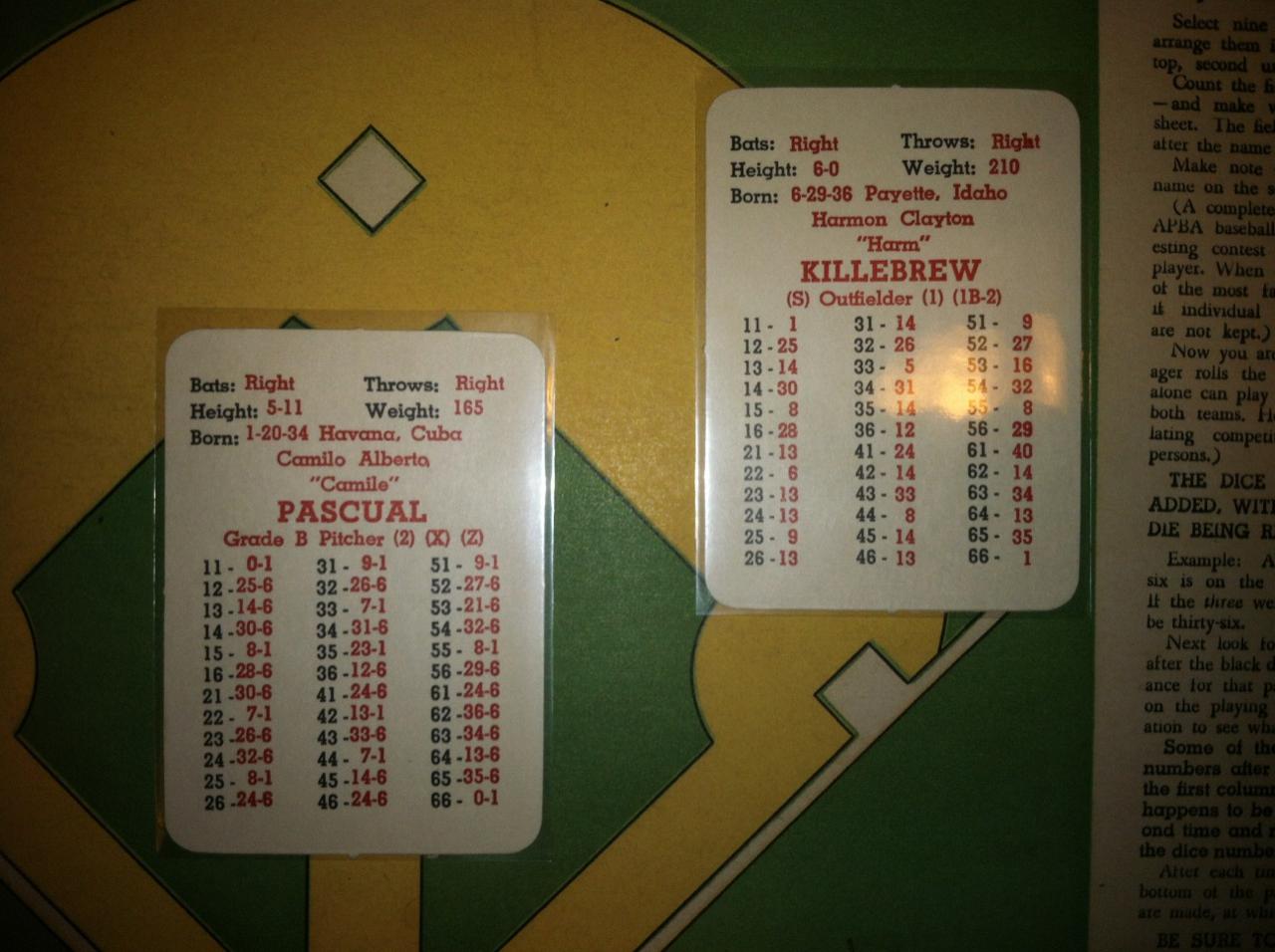 I don't like how the cards look so plain, how the card makers try to be cute by giving each player his full name plus his nickname, and how the batters do not have lefty/righty splits. Even worse, at first glance, the readings on the card give no indication of how strong or weak the card is. Apparently higher dice rolls mean better results, but you need to look up charts for each result. That shouldn't be a big deal for computer players, but if I ever play the C&D game that would be too much for me compared to the more obvious results that can be seen on a SOM card at first glance.
I don't like how the cards look so plain, how the card makers try to be cute by giving each player his full name plus his nickname, and how the batters do not have lefty/righty splits. Even worse, at first glance, the readings on the card give no indication of how strong or weak the card is. Apparently higher dice rolls mean better results, but you need to look up charts for each result. That shouldn't be a big deal for computer players, but if I ever play the C&D game that would be too much for me compared to the more obvious results that can be seen on a SOM card at first glance.
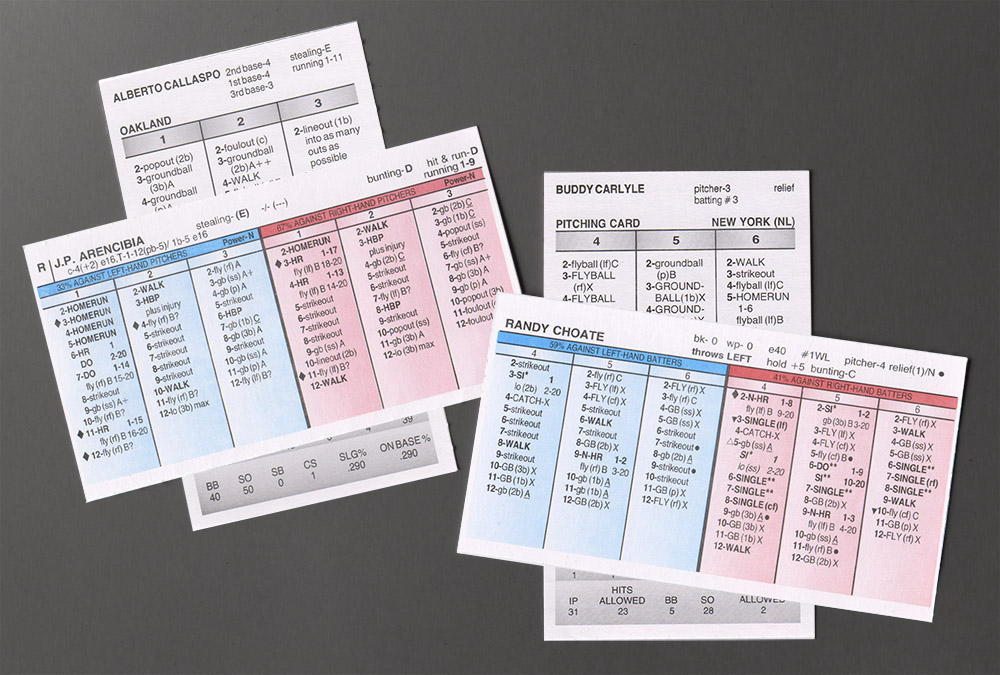
See the difference? One thing I didn't realize as a beginner, but know better now, is that the middle of the cards are the most likely result based on dice rolls (the number 7 from two six-sided dice). Thus at first glance I can tell without looking up anything that J.P. Arencibia is a bit stronger against left handed pitchers and I can tell that Randy Choate would best be used against left handed batters. For current APBA players who prefer no splits, that is an option in SOM too. See the black and white cards behind the colored cards in the photo above. :-) It is used by SOM players who choose ease of play over realism.
Replay Baseball, if memory serves me correct, has been said to be a bit more accurate than SOM. It also uses columns specific to pitching, defense, and so on. That way, their cards look less random than APBA's cards. See the excerpt from their website directly below:
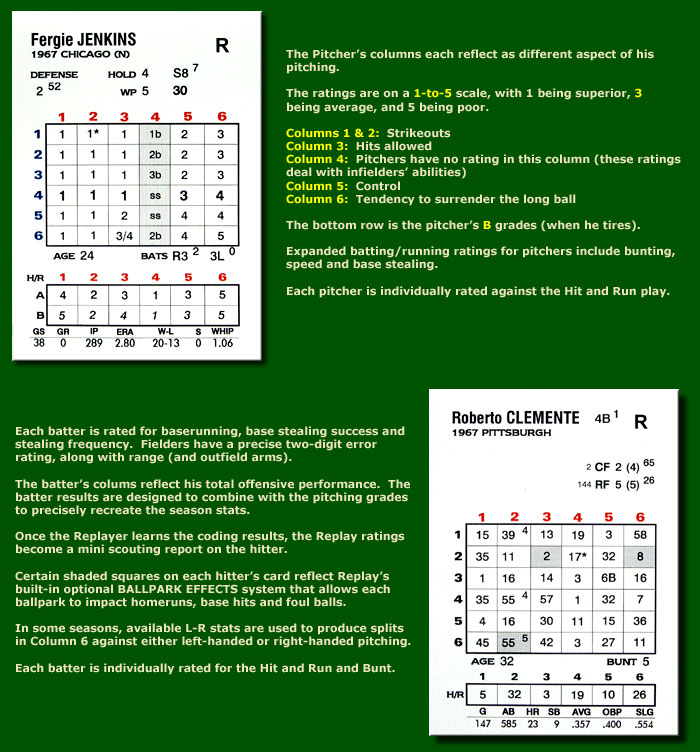 However, for C&D purposes, you still need to look up different charts for every single dice roll. SOM is easier than Replay Baseball for determining results by looking at the cards directly and by needing charts less frequently.
However, for C&D purposes, you still need to look up different charts for every single dice roll. SOM is easier than Replay Baseball for determining results by looking at the cards directly and by needing charts less frequently.
Dynasty League Baseball (formerly known as Pursue the Pennant) is the most intriguing competitor to SOM. Its online game can be played on any computer web browser, making the game more universally accessible to fans compared to the Windows-only SOM game. The cards look colorful and the game uses three 10-sided dices rather than SOM's three 6-sided dices plus a 20-sided die.
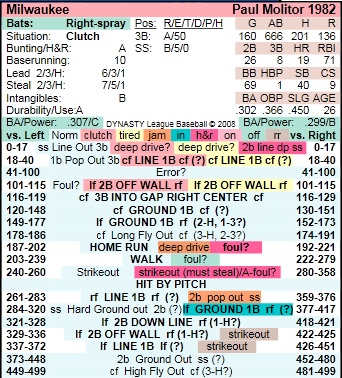
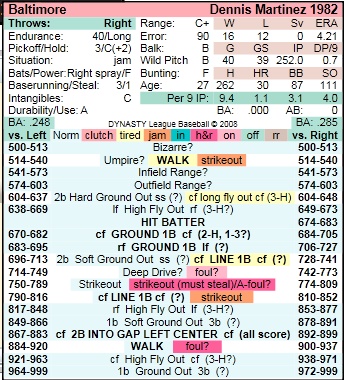
I like how the left-righty results are shown at a glance. The results in the middle are the same for lefty-righty, but the numbers on the left and right have different ranges. So from the image above, out of 499 possible dice results for Paul Molitor's card, when batting against the right-handed Dennis Martinez, Paul is most likely to be a strikeout victim since a 280-358 result is most likely to happen over all other dice results. However, SOM cards have 7 as the most common 2d6 result and if the rolls go up to 2, or down to 12, you are less likely to get those results. That is not the case for DL as you are more likely to roll a 41-100 than you are to roll a 0-17 in the same right-handed results column for Molitor. DL did very well to make the cards visually appealing and understandable, but SOM's cards require less calculating and estimating. In addition, I like how each dice result in SOM is important because a 4-8 result will be a walk and a 4-9 result will be a strikeout for a particular card. For DL there is no difference between rolling a 706 and a 707 if both results are in the same range. Some people might like that makes DL less random, but I like how SOM, especially when the computer game pauses briefly after the first dice roll, makes it more exciting. DL certainly gives a great effort to match the C&D playability of SOM. I would be playing it if SOM had never existed!
New for 3/28/2020!
I recently had time to do additional research and came across Inside Pitch Baseball. It is another intriguing alternative to SOM. The developer attempts to make the game more realistic. All matchups start with the pitcher's card, since all action goes through him (which makes sense if you think about it). If the roll does not yield an immediate result (for example, SOM's gb(P)B is an immediate result while gp(P)X is not), then the dice are re-rolled for the batter's card and/or the ballpark's card. Yes, ballparks have cards, and no, they are not optional. See the sample image below.

As you can see, the cards are showed in random arrangements of a 6x6 grid (roll 2d6 for results). It discourages "Stratballing" (making managerial decisions based on printed card results) which can be good or bad depending on your perspective. Looking through the game's annotated rules, Inside Pitch has some features not used in SOM such as pickoff attempts and attempting to get leads without catcher ratings. However, SOM still has triple plays from lineouts, the ability to score from 1B on a DOUBLE, and robbing home runs, for instance. The main attraction for the game is its pitcher-controlled mechanism. I know the developer is trying to take out an issue with SOM and similar games - there is a 50% chance your initial rolls will have nothing to do with the batter or pitcher. You could stick in Jose Canseco as a pitcher, for example, and many three-true-results sluggers of today's MLB would probably strike out against him! However Inside Pitch still has a good chance, depending on the pitcher's card, that either the pitcher or ballpark still cause the batter to be out regardless of the batter card being used. If nothing else, I like Inside Sports Games' unique approach to cards-and-dice baseball.
Final Standings
Below is how I would rank the C&D-with-computer-versions baseball games. Keep in mind that I have only played SOM, so your own ranking may differ.
- Strat-O-Matic Baseball
- Dynasty League Baseball
- Inside Pitch Baseball
- Replay Baseball
- APBA Baseball
The above games all have their fans and upon closer examination, their own pros and cons. I had already been playing SOM on the PC when I first researched the other games above. In the end, I am happy that SOM has been my first and only choice after all those years. If you are in the market for any of the games above, I hope you find my perspective useful. If I have overlooked a C&D-and-computer game not mentioned in this page, please let me know and I would love to take a look at it! Shoot me an email at moc.hcirtxet (read right to left).
Other Notes
A few years ago I read Jim Bouton books (Ball Four and I'm Glad You Didn't Take It Personally) to get myself more immersed in my 1969 Seattle Pilots replay. In the latter book, there is a chapter dedicated to fan mail (well, mostly from fans). I thought I would share one here, especially since that book was never sold as an ebook as far as I know.
"We are two high school seniors who are avid baseball fans. . . . Both of us agree with your feelings about Fred Talbot [TextRich's note - Talbot was a starter who didn't get along with Bouton in the Pilots before the former was traded to the Oakland A's.], and we feel we should inform you of a game that we invented two years ago. It was a baseball-dice game where hitters and pitchers were rated according to their talents. We designed it so that the better hitters would have a better opportunity to get a hit. (For you to get a hit, we had to throw 3 "6's" with the three dice provided.)
The pitchers were also rated acording to ability. In order to keep each game close we had a "FRED TALBOT" card. Any time one of us was leading by 10 or more runs, we were forced to bring in Talbot for 1 inning. Talbot's card had only one way to retire a batter; triple snake-eyes!"
Sincerely,
Wes Wenk
John Marx
Highland Park, Ill.
3 dices... it sounds a lot like those two boys were simply playing SOM with modified rules and without cards, or they couldn't wait for the 1969 set to come out after Ball Four was released in 1970. :-) Bouton's second book came out in 1971 and SOM was first released in 1961.
Go back to my Strat-O-Matic Baseball page.
©opyright 2025 by Richard Knopf
Updated March 28, 2020
 I don't like how the cards look so plain, how the card makers try to be cute by giving each player his full name plus his nickname, and how the batters do not have lefty/righty splits. Even worse, at first glance, the readings on the card give no indication of how strong or weak the card is. Apparently higher dice rolls mean better results, but you need to look up charts for each result. That shouldn't be a big deal for computer players, but if I ever play the C&D game that would be too much for me compared to the more obvious results that can be seen on a SOM card at first glance.
I don't like how the cards look so plain, how the card makers try to be cute by giving each player his full name plus his nickname, and how the batters do not have lefty/righty splits. Even worse, at first glance, the readings on the card give no indication of how strong or weak the card is. Apparently higher dice rolls mean better results, but you need to look up charts for each result. That shouldn't be a big deal for computer players, but if I ever play the C&D game that would be too much for me compared to the more obvious results that can be seen on a SOM card at first glance.

 However, for C&D purposes, you still need to look up different charts for every single dice roll. SOM is easier than Replay Baseball for determining results by looking at the cards directly and by needing charts less frequently.
However, for C&D purposes, you still need to look up different charts for every single dice roll. SOM is easier than Replay Baseball for determining results by looking at the cards directly and by needing charts less frequently.


